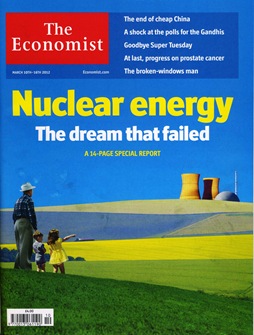This is what I learnt from the 16pp supplement in the latest edition of The Economist. It gives a sharply written, hard-headed assessment for the future of nuclear power in the aftermath of Fukushima. The subhead of the keynote piece by Oliver Morton reads: ‘Nuclear power will not go away, but its role may never be more than marginal.’
* Japan has a total of 54 reactors which in 2010, supplied Japan with 30% of its electricity from nuclear plants.. Only two are currently operating. More than a dozen are unlikely to reopen. The rest are presently shut down for maintenance or “stress tests” and are unlikely to be on-stream by the time the two still running shut for maintenance at the end of April. [To replace the power, old thermal plants are working at full capacity]
* Some 100,000 people have been evacuated from towns close to the Fukushima plant. Decommissioning and decontamination of the plant could cost as much as 50 trillion yen ($623 billion).
[See: FUKUSHIMA UPDATE site for latest news]
* ‘In liberalised energy markets, building nuclear power plants is no longer a commercially feasible option: they are simply too expensive.’
* ‘Worries about the dark side of nuclear power are resurgent thanks to what is happening in Iran.’ Nuclear proliferation has developed hand-in-hand with nuclear power. Israel is the only state that has nuclear weapons but no nuclear power stations. Only two non-European states with power stations – Japan and Mexico – have not taken steps towards developing nuclear weapons.
* In 2010, the world’s installed renewable electricity capacity outstripped its nuclear capacity for the first time. (we still get more energy from nuclear: reactors run at 93% capacity, renewables at 20% and the power is intermittent. On the other hand, nuclear is getting more expensive and renewables are getting cheaper.
*Germany may have abandoned nuclear power but it is not going to disappear.
* ‘It takes a decade or so to go from deciding to build a reactor to feeding the resulting electricity into a grid.’
* In 2010 nuclear power provided 13% of the world’s electricity, down from 18% in 1996.
*68% of the world’s nuclear electricity comes from Pressurised Water Reactors (PWRs), originally developed to power nuclear submarines.
*’More or less the only practical things you can do with a reactor are to make plutonium for bombs, power submarines, produce isotopes used in medicine and to generate heat and electricity. Only the last is big business and ir can easily be done by other means.’
*There are a number of big cities – London, New York, Hong Kong, Los Angeles – that are closer to ageing nuclear plants than Tokyo is to Fukushima.’
China
China is planning to increase its nuclear capacity from 10 GW to 80 GW by 2o2o; currently, nuclear generates less than 2% of China’s electricity. The planned expansion will make it less than 5%.
China ‘looks certain to build more new nuclear plants than any other country…and possibly more than all others combined.’ It will add more nuclear capacity in these 10 years than France has in total.
China consumes half the world’s annual coal output. China’s Greentech initiative has a 2020 target of 200GW of wind power and plans to add 100GW of hydropower.
At two sites on the north China coast. Work has already begun on two new Westinghouse AP 1000 reactors – the first to be built anywhere in the world. Plans are for 12 of these reactors on the two sites. Each site will have as much capacity connected to the grid as the whole of Nigeria.
Britain
*‘Whereas a few years ago Britain was talking of building eight new reactors to replace its ageing fleet, only two are likely to make it in the near future.’
Carbon Emissions
* By 2020, carbon emissions since the start of the 21st century will have surpassed those of the entire 20th. …In 2000,, the amount of carbon dioxide emitted by industry was about 30 billion tonnes, and was growing at 3% a year.
*It has been calculated that if we were able to replace 700 GW of coal-fired stations with nuclear reactors over 50 years – a trebling of global nuclear capacity – this would reduce annual CO2 emissions by 3.7 billion tonnes. This would compensate for just 4 years of emissions growth.
* ‘To have a reasonable chance of keeping the rise in temperature to less than 2 degrees C, industrial economies need to reduce emissions by 80% by 2050. The true scale of this challenge is not widely understood.’
* Renewables are getting cheaper and through technological change and the benefits of mass production and market competition. In the long run, technologies that get cheaper can be expected to edge out a technology that has only ever got more expensive. In a low-emissions world, the role for nuclear will be limited to whatever level of electricity demand remains when renewables are deployed as far as possible.’


No comments:
Post a Comment